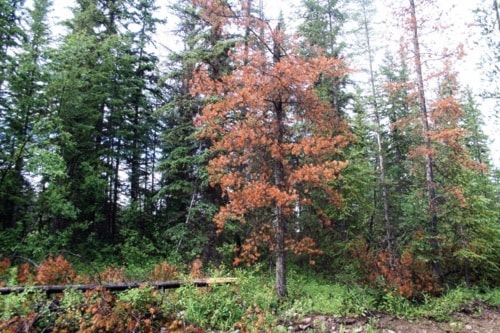Chief forester, Jim Snetsinger has made his determination following a review of the Lakes Timber Supply Area (TSA).
An annual allowable cut of two million cubic metres for the Lakes TSA, which takes effect immediately, has been set. This annual allowable cut is based upon information received by Snetsinger over the past several months during the timber supply review.
During the review, the chief forester must determine how much wood can be harvested in each of the province's 38 timber supply areas and 34 tree farm licences at least once every 10 years.
Snetsinger said to Lakes District News, "We look at all the information from various sources and from that, set a sustainable rate of harvest for the next five to 10 years."
In 2001, the annual allowable cut for the Lakes TSA doubled from 1.5 million cubic metres to approximately three million cubic metres annually.
According to Snetsinger, the significant increase was made to slow the spread of the mountain pine beetle infestation and to recover damaged timber.
The annual allowable cut was increased again in 2004 to about 3.2 million cubic metres per year.
Snetsinger said that despite the increased allowable harvesting levels in previous years, the actual harvest levels have averaged at approximately 1.6 million cubic metres per year.
"The new annual allowable cut determination has kept with harvest levels previously experienced in the Lakes TSA over the last few years and I think the decision is quite in line with what is happening in the Lakes TSA over the last five years." Snetsinger said that when he made his decision he took into account the fact that the local area had been hard hit by the mountain pine beetle.
"There is a 90 per cent mortality rate in some stands, which is very high."
"If the dead pine is still standing, then it has reached a state of dry equilibrium, there is no rot."
"Dead pine continues to be milled. When I was on a trip to Williams Lake just recently I saw loads of mountain pine beetle timber on the way to be milled."
According to Snetsinger, "As long as the trees are standing they can be milled."
Seventy four per cent of the Lakes TSA consists of pine, which the chief forester says is available for harvest.
"It is a significant area and as long as it is standing pine the industry tells me it is viable."
Snetsinger said market prices also determine viability and that there is a current demand from Chinese markets for lower grades of timber. "The ability to process dead pine all comes down to economics."
"The price of lumber is not tremendous, but it is still higher than it was."
There is also increasing demand for timber by-products and with a newly developed pellet mill in the local area, Snetsinger said that there will be demand for biomass.
While the annual allowable cut is still predicated on saw logs and pulp logs Snetsinger said he recognizes there is still available biomass in the timber stands.
"The annual allowable cut recognizes the merchantability of saw logs, but I know there is plenty of available biomass and non saw log component in the Lakes TSA that I know pellet producers in the local area would be very interested in," he said adding that the salvage of biomass is one of the reasons for his decision of two million cubic metres for the annual allowable cut.
The new determination also includes a partition that limits the harvest of non-pine timber species such as spruce, to 350,000 cubic metres per year. The other 1.65 million cubic metres per year are focused on continuing to recover value from beetle killed pine stands.
The partition and the decrease in cut are intended to conserve non-pine timber over the next 10 years. When dead pine stands are no longer suitable for harvesting, non-pine stands will be needed to support harvesting and other values, such as wildlife habitat, riparian areas and old growth.
"The key issue is how to manage the mature non-pine forest while new stands of young pine grow to merchantable size. The best way to mitigate the projected decrease in timber supply at the end of the decade is to continue to focus the harvest on beetle killed pine stands."
Local industry representatives had voiced their concerns over the dwindling amount of viable pine in the Lakes TSA and requested an amalgamation of TSA's however Snetsinger said that there is still a lot of viable pine in the Lakes TSA.
"This needs to be salvaged before there is any shifting of TSA's."
He added, if this decision is to be made, he would not be responsible for it as the decision would fall to the Ministry of Forest Lands and Natural Resource Operations.
Another issue that was brought up during the Lakes TSA review is the relaxation of visual quality objectives. During the review local forestry officials had called for the visual quality objectives to be relaxed to allow for the removal of more dead pine while it is still viable.
Snetsinger said that in this timber supply review there was not a relaxation of visuals however it is something that is being investigated.
"I know it is something that is currently being looked at, at district levels."
The Lakes TSA covers about 1.1 million hectares and includes Burns Lake, Decker Lake, Francois Lake, Grassy Plains and Danskin, as well as several First Nations reserves and communities.
For more information about the Lakes TSA or the rationale for the Lakes annual allowable cut determination go to www.for.gov.bc.ca/hst/
